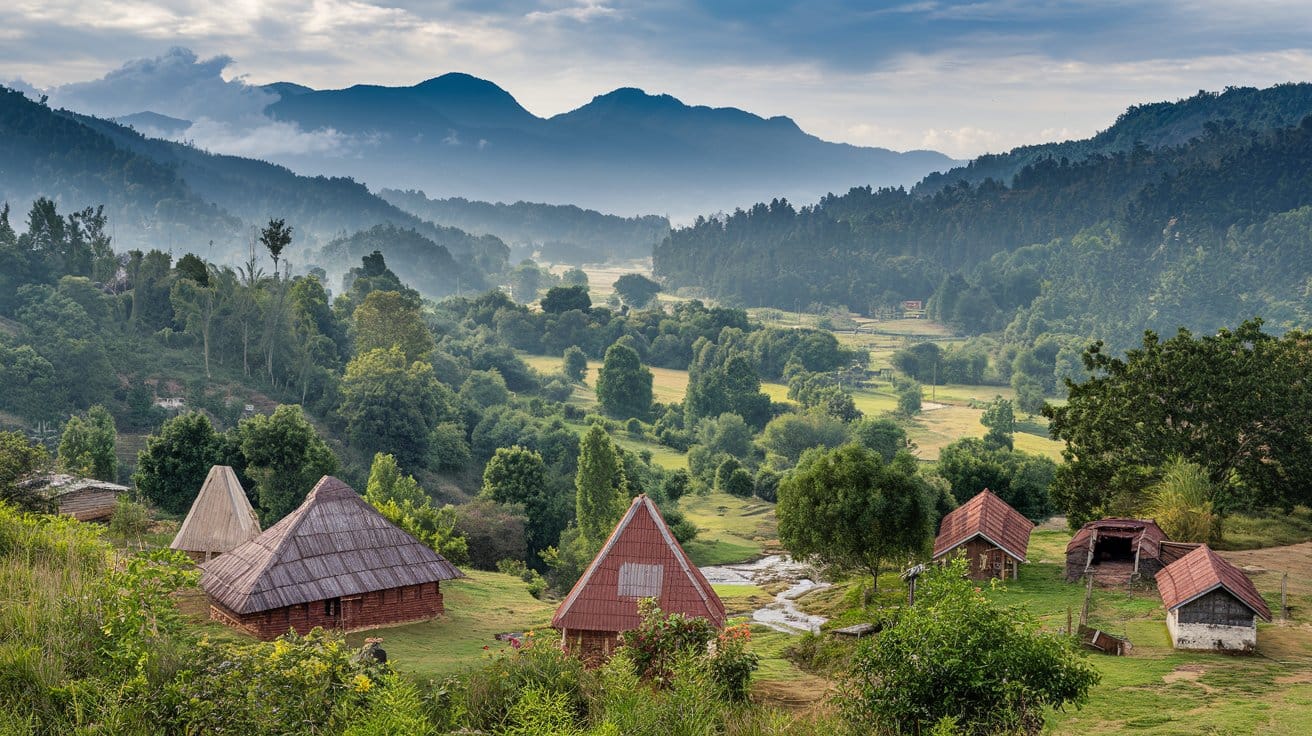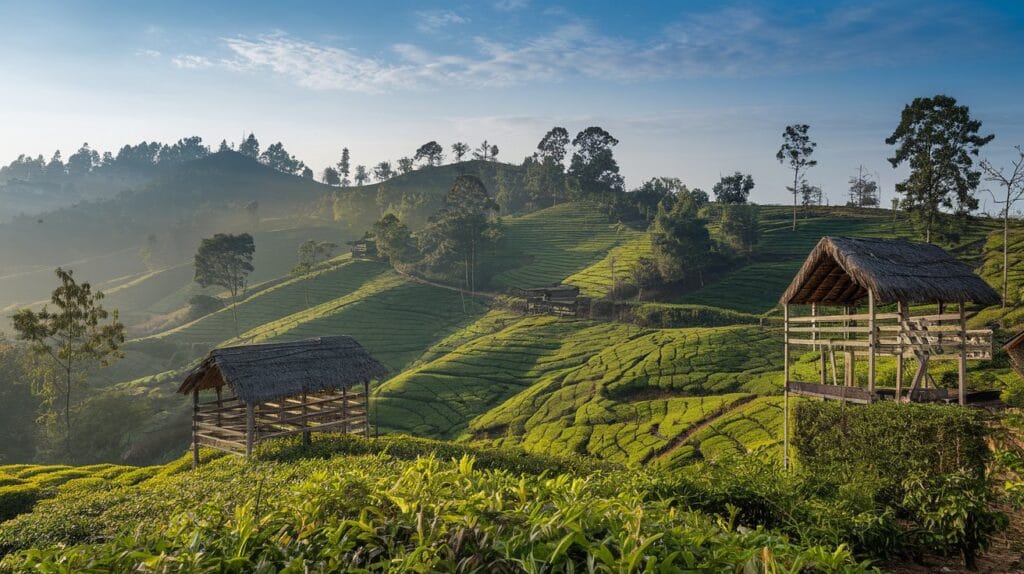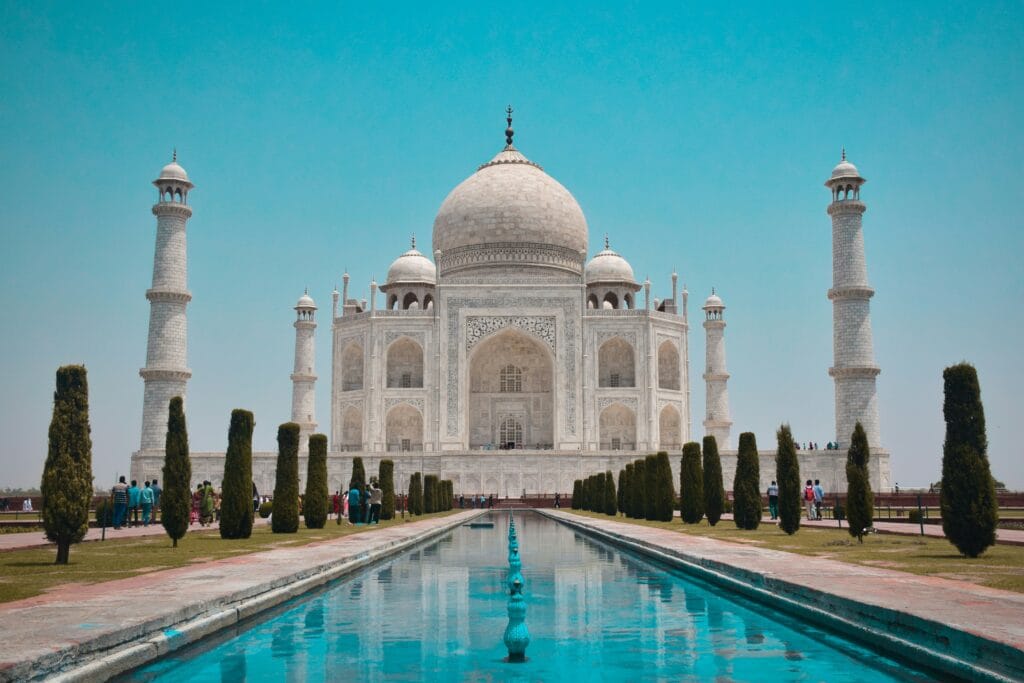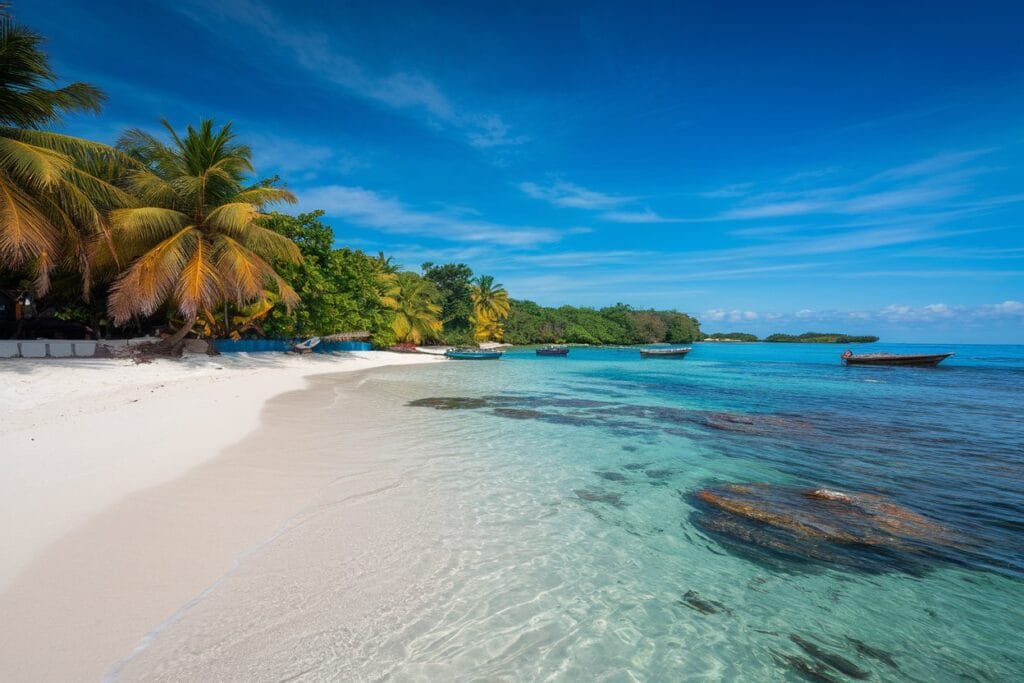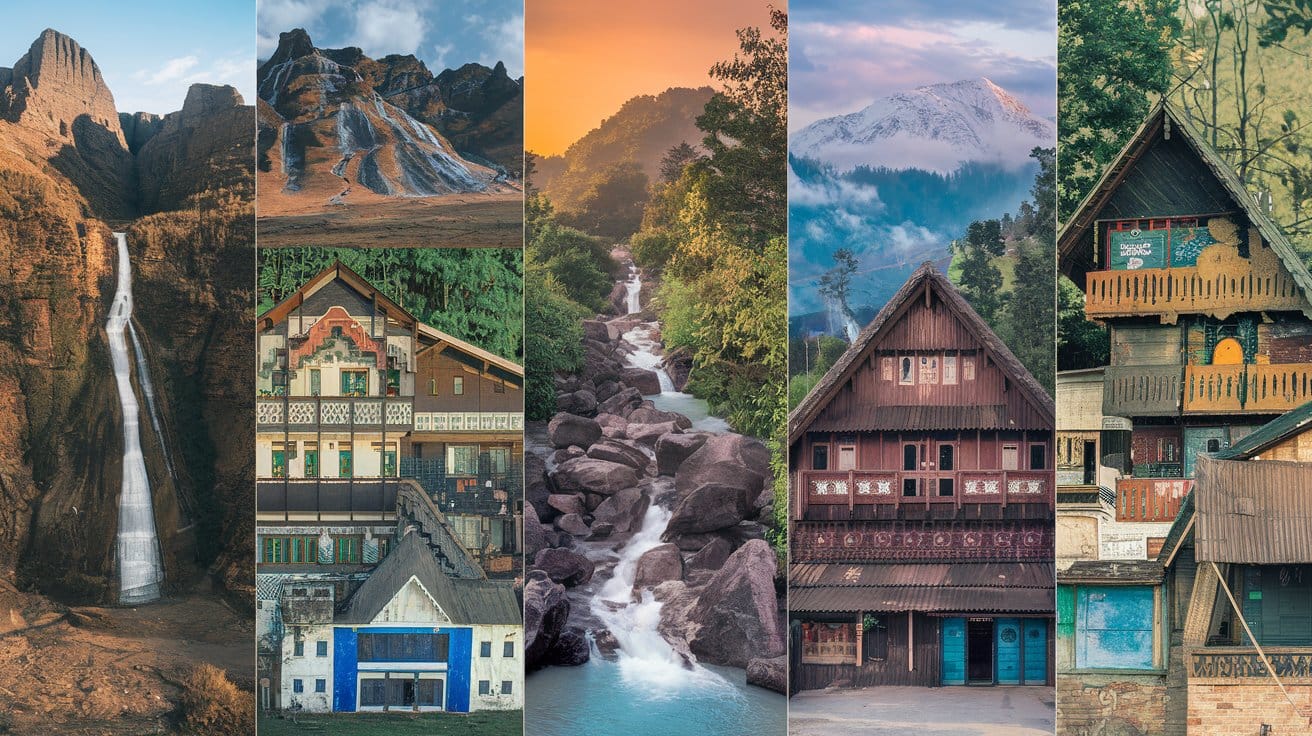
India's Seven Sisters States
Introduction
Tucked away in the northeastern corner of India, the Seven Sisters States comprise Arunachal Pradesh, Assam, Manipur, Meghalaya, Mizoram, Nagaland, and Tripura. These states are renowned for their unparalleled natural beauty, vibrant cultures, and rich traditions. Often referred to as “Paradise Unexplored,” the Seven Sisters offer a unique blend of scenic landscapes, diverse communities, and historical significance. Despite their remoteness, these states are integral to India’s cultural and geographical identity.
The Seven Sisters: A Quick Glimpse
Arunachal Pradesh
Arunachal Pradesh, often referred to as the “Land of the Rising Sun,” is a mesmerizing state in India’s northeastern region. It is the first Indian state to witness the sunrise, earning it this poetic title. Arunachal Pradesh is a haven for nature lovers, adventure seekers, and spiritual travelers alike, offering a blend of stunning landscapes, rich biodiversity, and profound cultural heritage.
Snow-Capped Mountains: A Traveler’s Paradise
The snow-capped mountains of Arunachal Pradesh stand as sentinels of beauty and adventure. The Eastern Himalayas traverse the state, providing a spectacular backdrop and opportunities for trekking, mountaineering, and nature exploration. The breathtaking peaks, such as Gorichen and Kangto, are not just geographical wonders but also hold cultural significance for the local tribes.
Dense Forests: A Treasure Trove of Biodiversity
Arunachal Pradesh is home to some of the densest forests in India, making it a biodiversity hotspot. The state boasts numerous national parks and wildlife sanctuaries, such as Namdapha National Park and Pakke Tiger Reserve. These forests are teeming with rare and exotic flora and fauna, including the red panda, clouded leopard, and hornbill. For nature enthusiasts, exploring these verdant landscapes is a once-in-a-lifetime experience.
Tawang Monastery: A Spiritual Haven
No visit to Arunachal Pradesh is complete without a trip to Tawang, home to the renowned Tawang Monastery. This 17th-century monastery, perched at an altitude of 10,000 feet, is the largest in India and the second-largest in the world. It serves as a significant spiritual center for Tibetan Buddhism and offers a serene atmosphere for visitors. The monastery’s intricate architecture, prayer wheels, and panoramic views of the surrounding valleys make it a must-visit destination.
Arunachal Pradesh is truly a gem among India’s Seven Sisters States, offering a unique blend of natural beauty, cultural richness, and spiritual depth. Whether you’re scaling its snowy peaks, wandering through its lush forests, or seeking solace in its monasteries, this state promises an unforgettable experience.
Assam
Assam, one of the most vibrant states among India’s Seven Sisters, is a land of unparalleled beauty and rich cultural heritage. Nestled in the northeastern part of the country, Assam is renowned for its sprawling tea gardens, the majestic Brahmaputra River, and the world-famous Kaziranga National Park. Each of these elements showcases Assam’s unique identity and its immense contribution to India’s natural and cultural wealth.
Tea Gardens: The Heart of Assam’s Economy
Assam’s tea gardens are an iconic symbol of the state. Known as the largest tea-producing region in India, Assam’s tea estates stretch across lush green hills and valleys, creating breathtaking vistas. The state’s unique climate, with abundant rainfall and humidity, imparts a distinctive flavor to Assam tea, making it highly sought after worldwide. Visitors to the state can explore tea estates, witness the intricate process of tea production, and even sample fresh brews. The tea gardens are not just an economic backbone but also a significant cultural element, reflecting Assam’s harmonious blend of nature and industry.
The Mighty Brahmaputra River: A Lifeline and Cultural Icon
The Brahmaputra River is the lifeblood of Assam, flowing majestically through its plains and shaping its geography and culture. One of the largest rivers in the world, the Brahmaputra plays a vital role in agriculture, transportation, and livelihoods in the region. It is also home to the famous Majuli Island, the largest river island in the world, which is a hub of Assamese culture and Vaishnavite traditions. Festivals like Brahmaputra Pushkaram celebrate the river’s spiritual significance, while activities like river cruises offer a unique way to experience its grandeur.
Kaziranga National Park: A UNESCO World Heritage Site
Kaziranga National Park is a jewel in Assam’s crown, attracting wildlife enthusiasts and nature lovers from around the globe. This UNESCO World Heritage Site is famed for being the natural habitat of the endangered one-horned rhinoceros, a species synonymous with Assam’s identity. Apart from rhinos, the park is home to tigers, elephants, wild buffaloes, and a variety of bird species. Visitors can embark on thrilling jeep safaris or elephant rides to explore the park’s diverse ecosystems, which include grasslands, wetlands, and forests. Kaziranga stands as a testament to Assam’s commitment to wildlife conservation and ecological balance.
Assam’s tea gardens, the Brahmaputra River, and Kaziranga National Park together weave a story of natural splendor, cultural richness, and ecological significance. As one of India’s Seven Sisters States, Assam continues to charm travelers and contribute to the nation’s heritage in countless ways.
Manipur
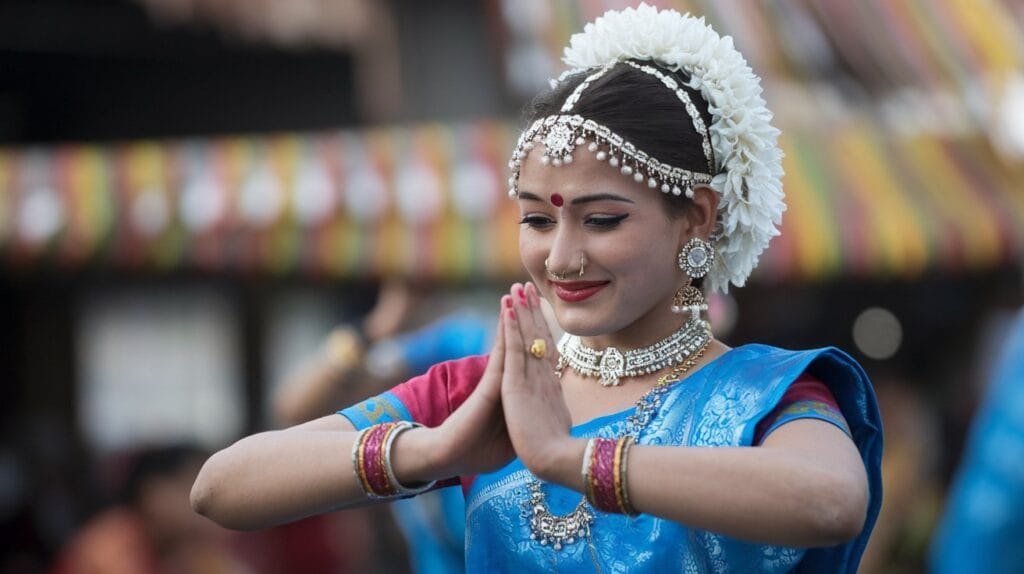
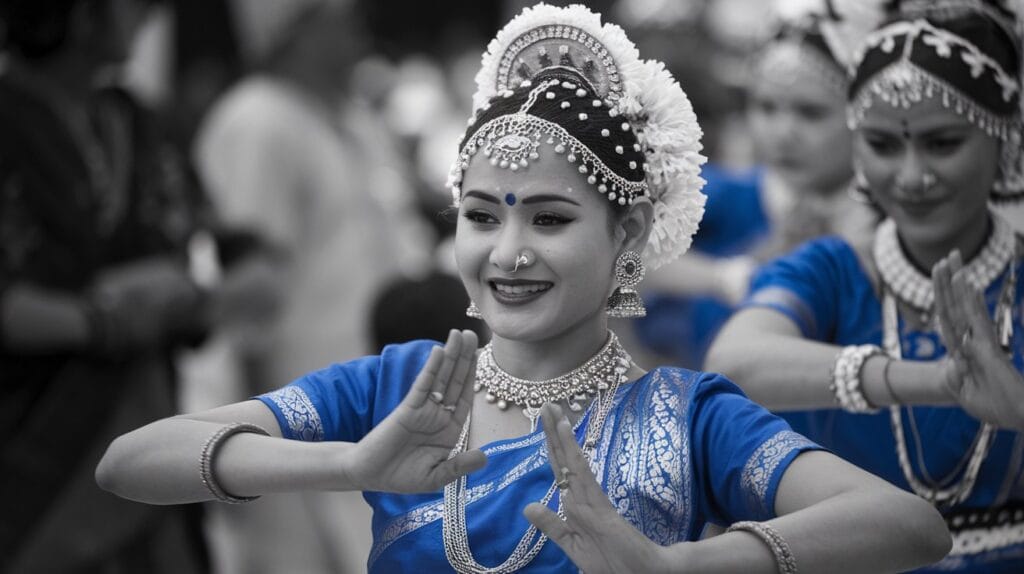
Manipur, one of the enchanting Seven Sisters States of India, is a land of natural beauty, vibrant culture, and timeless traditions. Often referred to as the “Jewel of India,” this picturesque state is a harmonious blend of scenic landscapes, historical significance, and artistic excellence. Known for its unique attractions such as Loktak Lake, its famed floating islands, and its rich tradition of dance and martial arts, Manipur truly offers an unforgettable experience.
Loktak Lake: The Floating Marvel of Manipur
Loktak Lake, the largest freshwater lake in northeastern India, is the pride of Manipur. What makes this lake truly unique are its “phumdis” — floating islands made of vegetation, organic matter, and soil. These phumdis provide shelter to diverse flora and fauna and are home to Keibul Lamjao National Park, the only floating national park in the world. This park is also the last natural habitat of the endangered Sangai deer, often called the dancing deer of Manipur. Visitors can explore Loktak Lake on traditional boats, marvel at its serene beauty, and witness the harmonious coexistence of nature and the local communities.
A Rich Tradition of Dance: Grace and Elegance
Manipur is widely celebrated for its classical dance form, Manipuri, which is deeply rooted in the state’s cultural and spiritual heritage. This dance form is known for its graceful movements, intricate hand gestures, and expressive storytelling, often depicting episodes from the life of Lord Krishna and Radha. The vibrant costumes, accompanied by soulful music, create a mesmerizing visual and auditory experience. Manipuri dance plays a significant role in festivals and cultural events, making it an integral part of the state’s identity.
Martial Arts: A Legacy of Strength and Skill
Manipur’s martial arts tradition, particularly Thang Ta, is a fascinating aspect of its heritage. Thang Ta, which translates to “Art of the Sword and Spear,” was historically practiced by the Meitei warriors and reflects the state’s valor and resilience. Today, it is preserved as a cultural art form and showcased in performances and demonstrations. Another traditional sport, Mukna, a form of wrestling, also highlights the physical prowess and cultural pride of the people of Manipur.
Manipur’s title as the “Jewel of India” is well-deserved, thanks to its unparalleled natural beauty, artistic heritage, and cultural depth. From the tranquil waters of Loktak Lake to the dynamic energy of its dance and martial arts, the state offers a unique glimpse into the rich tapestry of India’s northeastern region. As one of the Seven Sisters, Manipur shines as a symbol of diversity and tradition, captivating the hearts of all who visit.
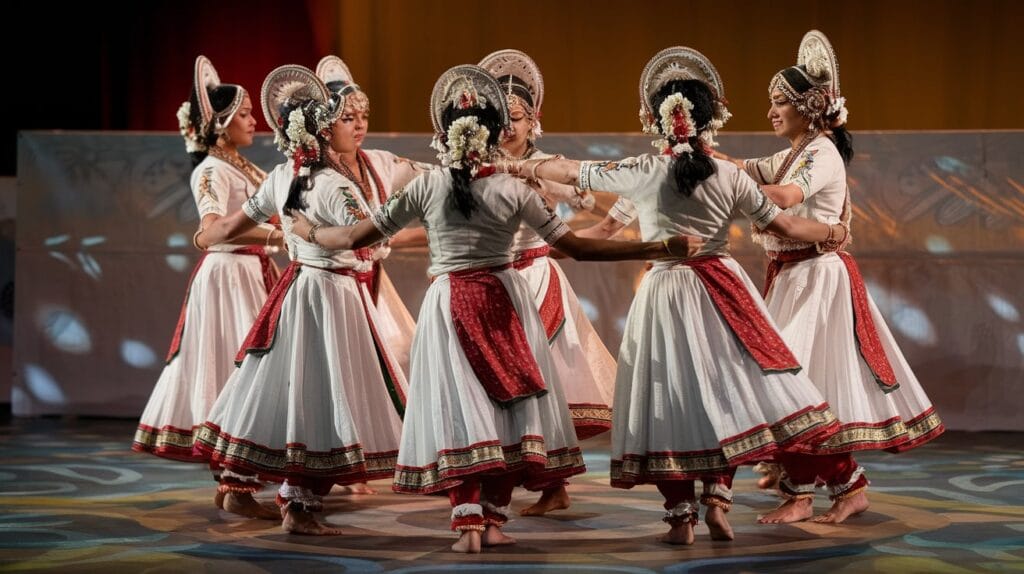
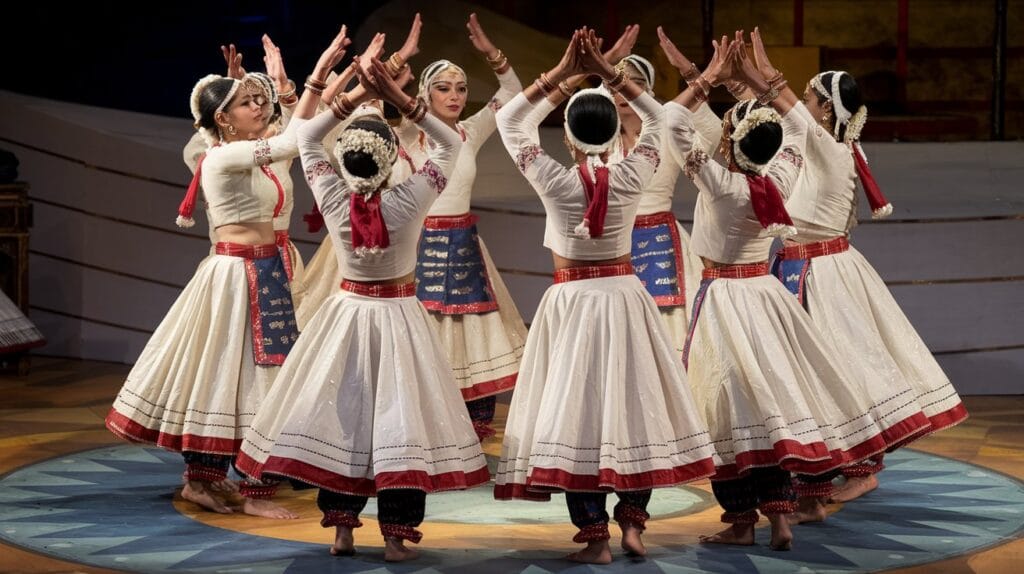
Meghalaya
Meghalaya, one of the stunning Seven Sisters States of India, is aptly named the “Abode of Clouds.” Nestled in the northeastern region of the country, Meghalaya is a treasure trove of natural wonders, rich cultural heritage, and unmatched scenic beauty. Famous for its living root bridges, record-breaking rainfall in Cherrapunji and Mawsynram, and vibrant traditions, Meghalaya attracts travelers seeking serenity and adventure alike.
Living Root Bridges: A Testament to Indigenous Ingenuity
The living root bridges of Meghalaya are a marvel of bioengineering and an incredible example of harmony between humans and nature. Created by the Khasi and Jaintia tribes, these bridges are made by guiding the roots of rubber fig trees across streams and rivers. Over decades, the roots grow strong enough to support the weight of people, turning into natural, sustainable pathways. The most famous of these bridges, such as the double-decker root bridge in Nongriat, offer a unique trekking experience and stand as symbols of Meghalaya’s ingenuity and ecological wisdom.
Cherrapunji: The Land of Eternal Rain
Cherrapunji, also known as Sohra, has long been celebrated as one of the wettest places on Earth. This picturesque town is famous for its mesmerizing waterfalls, lush green valleys, and mist-covered landscapes. Visitors can explore natural wonders like Nohkalikai Falls, the tallest plunge waterfall in India, and the Seven Sisters Falls, a breathtaking cascade that reflects the unity of the northeastern states. Beyond its natural beauty, Cherrapunji is a cultural hub where local Khasi traditions thrive.
Mawsynram: Breaking Rainfall Records
Mawsynram, a small village in Meghalaya, holds the title of the wettest place on Earth, receiving an average annual rainfall of over 11,800 mm. This extraordinary climatic phenomenon is a result of the region’s proximity to the Bay of Bengal and its unique topography. Visitors to Mawsynram can immerse themselves in the tranquility of its rain-soaked landscapes, explore ancient caves like Mawjymbuin Cave, and witness how the locals have adapted their lifestyle to thrive in this extreme environment.
Meghalaya’s breathtaking landscapes, innovative traditions, and vibrant culture make it a shining jewel among India’s Seven Sisters States. Whether you’re walking across a living root bridge, marveling at the perpetual rains of Cherrapunji, or experiencing the serenity of Mawsynram, Meghalaya offers an unparalleled journey into nature’s wonders and human resilience. As the “Abode of Clouds,” it promises to leave every traveler in awe of its beauty and charm.
Mizoram
Mizoram, one of the most enchanting Seven Sisters States of India, is a haven of natural beauty and cultural richness. Known as the “Land of the Blue Mountains,” this picturesque state is adorned with rolling hills, lush bamboo forests, and a vibrant cultural tapestry. Mizoram’s serene landscapes and unique traditions make it a must-visit destination for those seeking a blend of tranquility and cultural exploration.
Stunning Landscapes: Nature’s Masterpiece
Mizoram’s landscape is a stunning mosaic of rolling hills, emerald valleys, and cascading waterfalls. The state’s highest peak, Phawngpui, also known as the Blue Mountain, offers breathtaking panoramic views and a chance to explore its unique flora and fauna. Travelers can lose themselves in the pristine beauty of Vantawng Falls, the state’s highest waterfall, or enjoy the tranquil surroundings of Palak Lake, a natural sanctuary for birds and wildlife. Mizoram’s untouched beauty provides an ideal escape for nature lovers and adventure enthusiasts alike.
Bamboo Forests: A Green Treasure
Mizoram’s lush bamboo forests are not only a vital part of its ecosystem but also play an integral role in the lives of its people. Bamboo is deeply ingrained in Mizoram’s culture, economy, and daily life. The state’s bamboo crafts, ranging from furniture to decorative items, showcase the incredible skill and artistry of the local artisans. Additionally, these forests are home to diverse wildlife, making them a hotspot for eco-tourism and conservation efforts. Visitors can explore these green havens and gain insight into the sustainable practices of the local communities.
Vibrant Festivals: A Celebration of Life
Mizoram’s festivals are a true reflection of its vibrant culture and community spirit. One of the most celebrated festivals is Chapchar Kut, a spring festival that marks the clearing of bamboo forests for cultivation. The festival is an explosion of color, music, and dance, with traditional attire and joyful performances taking center stage. Another significant festival is Mim Kut, which honors departed souls and showcases the state’s traditional cuisine and rituals. Participating in these festivals offers a glimpse into Mizoram’s rich traditions and the warmth of its people.
Mizoram, with its breathtaking landscapes, lush bamboo forests, and lively festivals, is a gem among India’s Seven Sisters States. The “Land of the Blue Mountains” promises an unforgettable experience, where nature’s splendor meets cultural vibrancy. Whether you’re trekking through its hills, exploring its forests, or celebrating its festivals, Mizoram offers a journey that is as enriching as it is inspiring.
Nagaland
Nagaland, one of India’s captivating Seven Sisters States, is a realm of vibrant cultures, ancient traditions, and scenic landscapes. Known as the “Land of Festivals,” this northeastern state is home to 16 major tribes, each with its unique customs, languages, and attire. Nagaland’s colorful festivals, skilled artisans, and warm hospitality make it a fascinating destination for cultural enthusiasts and travelers alike.
The Hornbill Festival: A Grand Celebration of Culture
The Hornbill Festival, often referred to as the “Festival of Festivals,” is Nagaland’s most iconic event, held annually in December. Named after the revered hornbill bird, which holds a significant place in the folklore of the Naga tribes, this festival is a vibrant showcase of the state’s rich cultural heritage.
During the festival, visitors can witness traditional dances, music performances, and indigenous games, along with a display of tribal art and crafts. The Hornbill Festival also features a vibrant food arena, offering a chance to savor authentic Naga cuisine, including smoked pork, bamboo shoot delicacies, and spicy chutneys. The festival fosters unity among tribes and provides a platform for them to preserve and promote their traditions.
Intricate Handloom Work: Weaving Stories of Heritage
Nagaland’s handloom and handicrafts are a reflection of its rich tribal heritage and artistic excellence. The intricate patterns and vibrant colors of Naga shawls, scarves, and garments are symbolic of the tribe’s identity, social status, and cultural stories. Each design has a meaning, with motifs often inspired by nature, folklore, or historical events.
The handwoven textiles of Nagaland are crafted using traditional techniques passed down through generations. Women play a crucial role in preserving this art form, dedicating hours to create stunning pieces that are both functional and decorative. Visitors to Nagaland can explore local markets and craft centers to purchase authentic handloom products, which serve as beautiful souvenirs and support local artisans.
Nagaland, with its rich tribal traditions, grand festivals like the Hornbill Festival, and exquisite handloom work, stands as a testament to the cultural diversity of India’s Seven Sisters States. A visit to this enchanting land offers an opportunity to immerse oneself in its vibrant way of life and appreciate the timeless beauty of its traditions.
Tripura
Tripura, one of India’s charming Seven Sisters States, is a land of captivating history, magnificent architecture, and vibrant traditions. Located in the northeastern region of the country, Tripura offers a unique blend of cultural and historical attractions that reflect its rich legacy. From the grandeur of Ujjayanta Palace to its ancient temples and diverse cultural heritage, Tripura is a destination that leaves an indelible mark on all who visit.
Ujjayanta Palace: A Royal Marvel
Ujjayanta Palace, situated in the heart of Agartala, is one of Tripura’s most iconic landmarks. Built by Maharaja Radha Kishore Manikya in the early 20th century, this majestic palace is a blend of Mughal and Indo-European architectural styles. The white domes, sprawling gardens, and intricately designed interiors make it a sight to behold. Today, the palace serves as a museum, showcasing the rich history and culture of Tripura, including artifacts, paintings, and tribal heritage.
A visit to Ujjayanta Palace is like stepping back in time to witness the grandeur of Tripura’s royal past. The museum also provides an excellent opportunity to learn about the state’s diverse communities and their way of life.
Ancient Temples: A Spiritual Journey
Tripura is home to a number of ancient temples that reflect its deep-rooted spirituality and artistic brilliance. The Tripura Sundari Temple, also known as Matabari, is one of the 51 Shakti Peethas and a significant pilgrimage site for Hindus. Dedicated to Goddess Kali, this temple is an architectural masterpiece that draws devotees and tourists alike.
Another notable temple is the Bhuvaneshwari Temple, which holds historical and religious significance. Perched on the banks of the Gomati River, this temple’s intricate carvings and serene surroundings offer a sense of peace and tranquility. These sacred sites not only highlight Tripura’s spiritual essence but also serve as a testament to its rich cultural history.
A Rich Cultural Heritage: Diversity and Traditions
Tripura’s cultural heritage is a vibrant tapestry woven with the traditions of its tribal and non-tribal communities. The state is home to 19 tribal groups, each with its unique language, customs, and art forms. Traditional music, dance, and festivals play an integral role in the lives of the people of Tripura. The Garia Puja, a festival dedicated to the deity of wealth and prosperity, and Kharchi Puja, a celebration honoring the fourteen gods, are among the most prominent cultural events in the state.
Handicrafts are another highlight of Tripura’s cultural landscape. The state is renowned for its exquisite bamboo and cane products, including furniture, mats, and decorative items. These handcrafted pieces reflect the skill and creativity of the local artisans and make for perfect souvenirs.
Tripura, with its royal palaces, ancient temples, and vibrant cultural traditions, is a gem among India’s Seven Sisters States. A visit to this beautiful state promises an enriching experience, offering a glimpse into its historical grandeur and cultural diversity. Whether you’re exploring the halls of Ujjayanta Palace, seeking spiritual solace in its temples, or immersing yourself in its rich traditions, Tripura has something special for everyone.
Culture and Traditions of the Seven Sisters
The Seven Sisters are a treasure trove of cultural diversity. Each state is home to multiple tribes, each with its distinct customs, languages, and traditions. Festivals like Bihu in Assam, Sangai Festival in Manipur, and Hornbill Festival in Nagaland showcase the vibrant heritage of these states. Dance forms like Manipuri and tribal dances such as Cheraw (bamboo dance) from Mizoram add to the cultural richness. The Seven Sisters stand as a testament to the harmony and coexistence of diverse communities.
Natural Beauty and Landscapes
The Seven Sisters are a paradise for nature lovers. From the rolling hills of Meghalaya to the pristine valleys of Arunachal Pradesh, the region is blessed with incredible biodiversity. National parks like Namdapha in Arunachal Pradesh and Kaziranga in Assam are havens for wildlife enthusiasts. The rivers, waterfalls, and caves scattered across these states create some of the most picturesque landscapes in the country. Trekking, camping, and river rafting are popular activities for adventurers.
Culinary Delights of the Seven Sisters
The cuisine of the Seven Sisters is as diverse as their culture. Each state offers a unique culinary experience, with ingredients often sourced from the forests and local markets. Must-try dishes include:
- Assam: Assam’s fish curry (Masor Tenga) and bamboo shoot pickle.
- Manipur: Eromba (a tangy dish made with fermented fish) and Singju (a spicy salad).
- Mizoram: Bai (a stew of vegetables and bamboo shoot).
- Nagaland: Smoked pork with fermented bamboo shoots.
- Meghalaya: Jadoh (a rice and meat dish) and Dohneiiong (pork in black sesame sauce). These dishes offer a taste of the region’s love for simple yet flavorful meals.
Historical Significance of the Northeastern States
The Seven Sisters have a rich historical and cultural heritage. Ancient trade routes, such as those connecting India to Southeast Asia, passed through these states. Monasteries, temples, and tribal folklore reflect the region’s spiritual depth. Arunachal Pradesh’s Tawang Monastery is one of the largest in Asia, while Assam’s Kamakhya Temple is a major pilgrimage site. Additionally, the region played a pivotal role during India’s freedom struggle and the World War II battles in Nagaland and Manipur.
Folk Art and Handicrafts of the Seven Sisters
The Seven Sisters are known for their exquisite handloom and handicraft traditions. Each state has its signature style:
- Arunachal Pradesh: Handwoven shawls and carpets.
- Assam: Muga silk and bell metal crafts.
- Nagaland: Intricately designed Naga shawls and bamboo crafts.
- Meghalaya: Cane furniture and Khasi bamboo work. These crafts not only reflect the artistic skills of the tribes but also support local economies.
Challenges and Opportunities in the Seven Sisters States
Despite their beauty and cultural wealth, the Seven Sisters face challenges such as inadequate infrastructure, limited connectivity, and economic disparities. However, there are immense opportunities for growth through tourism, sustainable development, and investment in local industries. Government initiatives like the Act East Policy aim to improve connectivity and economic integration with Southeast Asia, promising a brighter future for the region.
Travel Tips for Exploring the Seven Sisters
Traveling to the Seven Sisters requires some planning due to their remote locations and diverse terrain. Here are a few tips:
- Best Time to Visit: October to April, when the weather is pleasant.
- Permits: Some states, like Arunachal Pradesh, require Inner Line Permits (ILP).
- Transport: Opt for local transport to explore the interiors but be prepared for long journeys.
- Stay Options: Homestays and eco-resorts are great ways to experience local hospitality. Carry cash, as ATMs may be limited in remote areas, and respect local customs and traditions.
Conclusion: Celebrating the Diversity of the Seven Sisters
India’s Seven Sisters States are a testament to the nation’s diversity and resilience. From breathtaking landscapes to rich cultural heritage, these states offer an experience unlike any other. By exploring and celebrating the Seven Sisters, we honor the beauty and diversity that make India truly incredible.
FAQs
The name represents the cultural and geographical unity among the seven northeastern states of India.
Arunachal Pradesh is known as the “Land of the Rising Sun.”
October to April is the best time due to pleasant weather and festivals.
Yes, some states like Arunachal Pradesh and Nagaland require Inner Line Permits (ILP) for visitors.
The cuisine features fresh, locally sourced ingredients, with unique flavors like bamboo shoots and fermented products.

